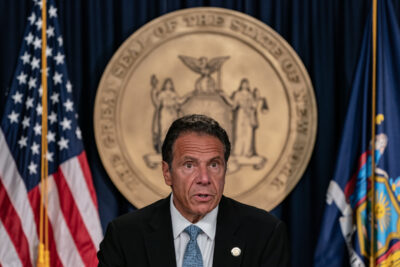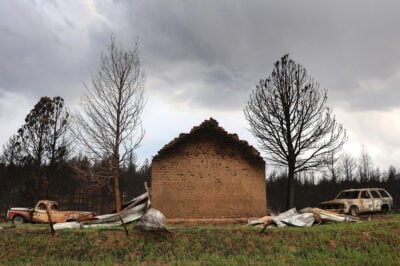ProPublica is a nonprofit newsroom that investigates abuses of power. Sign up to receive our biggest stories as soon as they’re published.
New York Gov. Andrew Cuomo’s latest book, “American Crisis: Leadership Lessons From the COVID-19 Pandemic,” went on sale this month. Its publisher has hailed the governor’s courageous honesty.
“Real leadership, he shows, requires clear communication, compassion for others, and a commitment to truth-telling — no matter how frightening the facts may be,” one bit of advertising for the book reads.
Here’s one hard truth Cuomo has still yet to tell: how many New York nursing home residents have died of COVID-19.
Nine months into the pandemic, and three months after his health commissioner testified that he was hard at work counting nursing home deaths, Cuomo has not announced the grim total.
“The governor has time, in the middle of a pandemic, to write a book on the COVID-19 crisis, but after months of delay he has not delivered on his word to provide the legislature with the accurate numbers of nursing home deaths,” said Ron Kim, a Democratic state legislator from Queens. “As a result, we are squandering away an opportunity to demonstrate how his government can be there to respond to this crisis.”
To date, Cuomo has only publicly acknowledged nursing home residents who died of COVID-19 inside their residences, some 6,500 people. While other states have all along combined those deaths with those of nursing home residents who died at hospitals, and made those totals public, New York has not.
Cuomo’s health commissioner, Howard Zucker, testified before state lawmakers in early August that the administration would not announce the total until it had done a careful review. He has so far declined to say why counting deaths in the state’s hospitals is taking so long.
“You know me,” Zucker told lawmakers during sworn testimony in August. “I will not provide information unless I know that it is absolutely accurate.”
The Cuomo administration did not respond to a request for an update and comment on criticism.
This fall, the Empire Center for Public Policy, an independent think tank in Albany, sued the State Department of Health to release full data on nursing home COVID-19 deaths. Bill Hammond, a senior fellow at the center, reported recently that the department had responded to the suit by saying it could not comply because “a diligent search for relevant documents is still being conducted.”
“It’s unfortunate that Gov. Cuomo continues using skewed facts and disingenuous arguments in a book that purports to draw lessons from the pandemic,” Hammond told ProPublica. “If we’re going to improve our public health defenses against future viruses, we need honest analysis of what happened, not self-justifying spin.”
The question of nursing home deaths has dogged Cuomo virtually since the outbreak of the pandemic. He announced that protecting the state’s roughly 600 facilities was his top priority. But under a policy he enacted in late March, more than 6,400 patients sick with COVID-19 were sent from hospitals to nursing homes without being tested to see if they were still contagious.
The policy was adopted out of a fear that hospitals would become overwhelmed during the initial surge of infections and deaths. As a result, the policy allowed patients deemed “medically stable” to be sent to nursing home facilities.
The policy enraged families, home administrators, epidemiologists and politicians of both major parties. Historically, nursing homes have struggled to limit outbreaks of infectious disease, in part because they have large staffs that come and go and often work at other facilities. Admitting sick COVID-19 patients, to many, seemed a needless added risk.
Cuomo declared an end to the practice six weeks after its implementation, but he insists to this day that COVID-19 patients sent to the homes were not a significant driver of subsequent infection and death.
In an effort to defend the policy that sent COVID-19 patients to nursing homes, Cuomo’s Health Department produced what it said was a peer-reviewed report showing it was infected staff members who drove nursing home infections and deaths. The report cited a variety of data to support its conclusions — how many homes had been infected before hospital patients arrived, the median number of days that had elapsed from the time the patients tested positive to when they were sent to the homes and more.
Yet state officials have maintained that accurately tabulating total deaths nine months into the pandemic is up to now beyond them.
In his book, Cuomo cites the report in support of his claim that the policy was not responsible for large numbers of infections and deaths. He maintains that the rules governing sending patients to homes was not, in fact, a formal policy, but merely guidance, and that no home should have accepted a person sick with COVID if it couldn’t safely care for him or her.
He writes that the state’s efforts to better protect the homes were undermined by how widely the virus had spread even early on and how limited the state was in its ability to conduct aggressive testing of staff and residents. He writes that criticism of his performance on nursing homes was the organized and cynical work of Republicans looking to avoid accountability for their own failures in the face of the crisis.
In October, ProPublica asked the Health Department to account for the time the count was taking.
“We are carefully reviewing all previous data, as the commissioner committed to, and we’re also requiring confirmatory and post mortem testing for anybody who may have had COVID-19 or flu symptoms, or exposure to someone who did, to ensure data integrity,” Jonah Bruno, a department spokesman, said.
Cuomo, in his book, was as he has been in public — withering in his criticism of President Donald Trump and his administration. He portrays the administration as ignornant, incompetent, dishonest and more concerned with public relations spin than saving lives.
His administration was different.
“Donald Trump did not have the only microphone,” Cuomo wrote. “I had one, too. And I had something else — credibility.”
So far, Cuomo has not used that microphone to deliver the hard truth of the state’s tragic loss of life.




